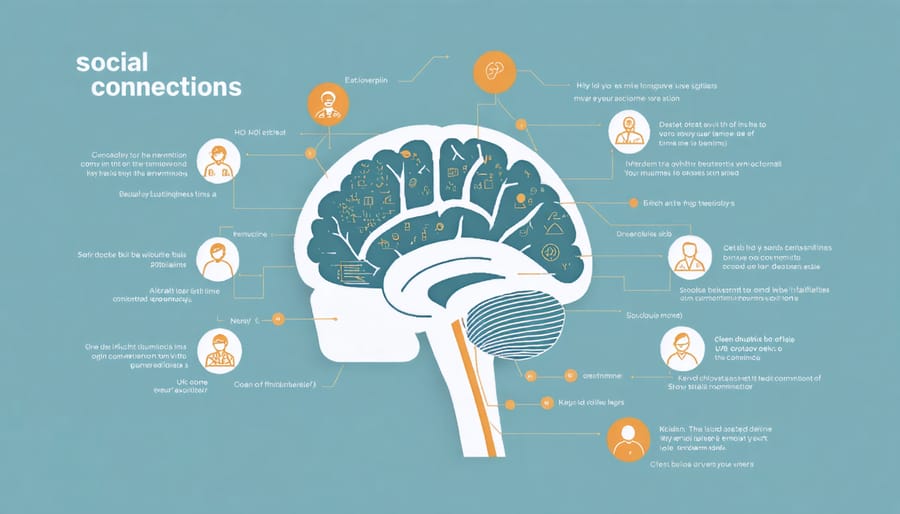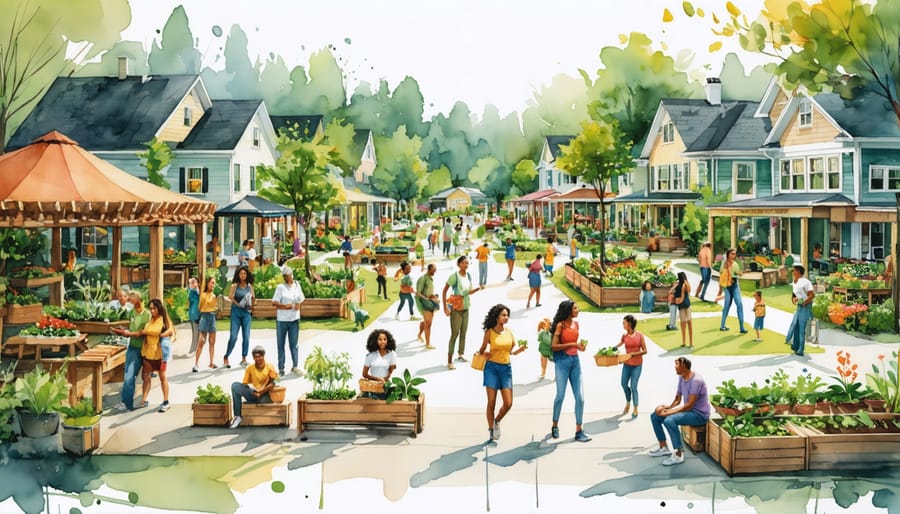Community health extends far beyond individual wellness, shaping the very fabric of our society and determining the quality of life for millions of Canadians. When neighbourhoods thrive together, rates of chronic disease drop significantly, mental health outcomes improve, and healthcare costs decrease by up to 30%, according to recent Statistics Canada data.
The interconnected nature of community wellbeing becomes strikingly clear in times of crisis. From the collective response to COVID-19 to addressing climate-related health challenges, strong community networks have proven essential for public health resilience. Research shows that communities with robust social connections experience 25% lower rates of depression and anxiety, while their residents live an average of five years longer than those in isolated environments.
Yet community health isn’t just about medical services or emergency response systems. It encompasses everything from accessible green spaces and food security to social support networks and educational programs. In Canadian communities where collaborative health initiatives have been implemented, researchers have documented a 40% increase in physical activity levels and a 35% improvement in reported mental wellness scores.
By understanding and investing in community health, we’re not just building healthier individuals – we’re creating stronger, more resilient societies capable of facing tomorrow’s challenges together.
The Science Behind Social Bonds and Mental Wellness

How Social Connections Change Your Brain
Recent research reveals that social connections literally reshape our brains in positive ways. When we engage with our community, our bodies release oxytocin, often called the “bonding hormone,” which helps reduce stress and anxiety while promoting trust and empathy.
Regular social interaction stimulates the production of neurotransmitters that improve mood and cognitive function. Studies show that people with strong social networks have better memory retention and slower cognitive decline as they age. This is particularly evident in seniors who participate in community activities and maintain regular social connections.
The brain’s neural pathways are strengthened through social engagement, similar to how exercise strengthens muscles. Meaningful conversations, shared activities, and emotional support from community members activate multiple areas of the brain, including those responsible for memory, emotion regulation, and decision-making.
Scientists have found that individuals who maintain strong social connections have lower levels of stress hormones like cortisol. This reduction in stress hormones contributes to better immune function, improved heart health, and enhanced overall well-being. Even brief positive social interactions can trigger beneficial changes in brain chemistry that last for hours.

The Mental Health Benefits of Belonging
Research consistently shows that being part of a community significantly improves mental health and emotional well-being. Studies from Canadian mental health organizations have found that people who feel connected to their community experience lower rates of anxiety and depression, and report higher levels of life satisfaction.
The sense of belonging we get from community involvement triggers the release of positive hormones like oxytocin and serotonin, which help reduce stress and promote feelings of happiness. Regular social interactions within community settings can also act as a natural buffer against loneliness, which has become increasingly recognized as a serious public health concern.
Community engagement provides opportunities for emotional support, shared experiences, and meaningful connections. Whether it’s participating in local sports teams, joining community gardens, or attending neighbourhood events, these activities create a support network that can help during challenging times.
For seniors particularly, community involvement has been linked to better cognitive function and a reduced risk of age-related mental decline. The intergenerational connections formed through community activities can provide purpose and foster a sense of legacy, contributing to overall mental wellness.
Building Stronger Community Ties in Modern Canada
Digital and In-Person Connection Strategies
In today’s interconnected world, building strong community bonds requires a thoughtful blend of both traditional face-to-face interactions and digital community connections. While online platforms offer convenience and broader reach, in-person meetings create deeper emotional connections that are essential for lasting relationships.
To maximize community engagement, consider participating in local community centre programs, neighbourhood walking groups, or wellness workshops while also joining online support groups and virtual fitness classes. This hybrid approach ensures you stay connected even when physical meetings aren’t possible.
For in-person connections, try:
– Joining community garden initiatives
– Attending local health and wellness events
– Participating in neighbourhood clean-up drives
– Volunteering at community health clinics
For digital engagement, consider:
– Following local health organizations on social media
– Joining neighbourhood groups on platforms like Facebook
– Participating in virtual wellness challenges
– Attending online community council meetings
The key is maintaining balance. While technology helps us stay connected, it shouldn’t replace face-to-face interactions entirely. Schedule regular in-person meetups with online connections when possible, and use digital tools to enhance rather than substitute real-world relationships. This balanced approach helps create a more resilient and supportive community network.

Finding Your Community Focus
Finding your ideal community group starts with identifying your personal interests and health goals. Consider what matters most to you – whether it’s physical activity, mental wellness, healthy eating, or social connection. Make a list of these priorities to help narrow down your search.
Start by exploring local community centres, libraries, and recreational facilities in your area. Many Canadian municipalities offer programs specifically designed to promote community health and wellness. Check your city’s website or community bulletin boards for upcoming events and ongoing programs.
Social media platforms and community apps can also help you discover groups that align with your interests. Look for local Facebook groups, Meetup events, or neighbourhood platforms where people share similar health and wellness goals.
When evaluating potential groups, consider practical factors such as:
– Meeting times and location accessibility
– Group size and atmosphere
– Cost and commitment level
– Leadership and organization structure
– Alignment with your personal values
Don’t hesitate to try different groups before settling on one that feels right. Many organizations offer trial periods or welcome visitors to observe their activities. Remember that finding the right community fit might take time, but the benefits to your overall health and well-being are worth the effort.
Start small by attending one or two group sessions per month, then gradually increase your involvement as you become more comfortable. Most importantly, choose activities that bring you joy and motivation to participate regularly.
Overcoming Social Anxiety Barriers
Building community connections can feel overwhelming when dealing with social anxiety, but there are effective strategies to help you overcome these challenges. Managing social anxiety starts with taking small, manageable steps toward social interaction.
Begin by setting realistic goals for yourself, such as attending one community event per month or introducing yourself to one new neighbor. Practice deep breathing exercises before social situations to help calm your nerves and maintain perspective.
Consider starting with structured activities where social interaction isn’t the main focus, such as joining a walking group or participating in a community garden project. These activities provide natural conversation starters and allow you to interact at your own pace.
Technology can be a helpful stepping stone. Join local online community groups or forums first, then gradually transition to in-person meetups when you feel ready. Many Canadian communities offer social anxiety support groups where you can connect with others who understand your challenges.
Remember that it’s okay to step back when feeling overwhelmed. Focus on progress rather than perfection, and celebrate small victories. If your anxiety feels unmanageable, consider reaching out to a mental health professional who can provide additional coping strategies and support tailored to your needs.
Maintaining Healthy Community Relationships
Setting Healthy Boundaries
While community engagement is vital for overall well-being, establishing and maintaining healthy boundaries is equally important. These boundaries help prevent burnout, protect your mental health, and ensure sustainable community participation.
Start by identifying your personal limits and comfort zones. Consider how much time and energy you can realistically commit to community activities without compromising your well-being. It’s perfectly acceptable to say “no” to additional commitments when you’re already at capacity.
Create clear schedules that balance community involvement with personal time. Set specific hours for community work and ensure you have dedicated time for self-care, family, and rest. Remember that maintaining these boundaries isn’t selfish—it’s essential for long-term community participation.
Practice effective communication about your boundaries. Be direct but polite when expressing your limits to others. For example, if you’re asked to take on additional responsibilities, you might say, “I appreciate you thinking of me, but I need to decline to maintain a healthy balance in my life.”
Digital boundaries are increasingly important in community health. Consider setting guidelines for when you’ll respond to community-related messages and emails. You might designate specific times for checking community group chats or social media platforms.
Watch for signs that your boundaries need adjustment, such as feeling overwhelmed, irritable, or experiencing physical exhaustion. These signals indicate it’s time to reassess and perhaps scale back your commitments.
Remember that healthy boundaries foster stronger, more sustainable community relationships. By taking care of yourself, you’re better equipped to contribute meaningfully to your community’s well-being.
Contributing to Community Wellbeing
Contributing to community health is both a responsibility and an opportunity that benefits everyone involved. Start by volunteering with local health organizations or community centers, where you can directly impact the wellbeing of your neighbours. Many Canadian communities offer programs that match volunteers with seniors who need companionship or assistance with daily activities.
Consider joining or starting a community garden, which not only provides fresh, healthy produce but also creates opportunities for social connection and physical activity. These spaces often become hubs for health education and sharing of nutritional knowledge.
Participating in local health initiatives, such as wellness fairs, vaccination drives, or mental health awareness campaigns, helps strengthen community resources. You can also advocate for health-promoting policies at municipal meetings or join your neighborhood association to voice concerns about community health issues.
Supporting local farmers’ markets and food security programs ensures better access to nutritious food for all community members. Getting involved in recreational sports leagues or fitness groups not only improves your health but also builds social connections that contribute to community resilience.
Share your skills and knowledge by organizing workshops on health-related topics, such as stress management or healthy cooking. Many community centers welcome volunteer instructors who can contribute to public health education.
Remember that small actions matter too. Being a good neighbor, checking on elderly community members during extreme weather, and participating in neighborhood clean-up events all contribute to a healthier community. By actively engaging in these activities, you help create a stronger, more resilient community that supports the wellbeing of all its members.
When to Seek Professional Support
While community support plays a vital role in maintaining health and wellness, there are times when seeking professional mental health support becomes essential. Recognizing these moments early can prevent health challenges from escalating and ensure you receive appropriate care.
Watch for these key indicators that suggest professional intervention may be needed:
Physical Health Concerns:
– Persistent symptoms that don’t improve with lifestyle changes
– Sudden unexplained changes in weight, sleep patterns, or energy levels
– Chronic pain or discomfort that affects daily activities
– Difficulty managing existing health conditions
Mental and Emotional Signs:
– Feeling overwhelmed by daily tasks or responsibilities
– Persistent sadness, anxiety, or mood changes lasting more than two weeks
– Withdrawal from social activities or relationships
– Changes in appetite or sleep patterns
– Difficulty concentrating or making decisions
Social and Community-Related Issues:
– Inability to maintain relationships or participate in community activities
– Feeling isolated despite community involvement
– Experiencing conflict in group settings that affects your well-being
– Difficulty accessing or utilizing community resources
Remember that seeking professional help isn’t a replacement for community support but rather a complementary resource. Many healthcare providers work collaboratively with community organizations to provide comprehensive care. Your family doctor can often serve as an excellent starting point, helping to coordinate various aspects of your care and referring you to appropriate specialists when needed.
Don’t hesitate to reach out to healthcare professionals if you’re unsure about your situation. Early intervention often leads to better outcomes and can help you maintain stronger connections within your community. Many Canadian healthcare providers now offer virtual consultations, making professional support more accessible than ever.
Community health is a shared responsibility that affects every Canadian’s well-being. By understanding the vital connection between social bonds and health outcomes, we can take meaningful steps to strengthen our communities and improve collective wellness. Remember that small actions matter – whether it’s joining a local fitness group, volunteering at a community garden, or participating in neighborhood health initiatives. Regular engagement with community programs not only enhances individual health but also creates a ripple effect of positive change throughout society. Take action today by reaching out to local health organizations, connecting with neighbors, or starting a wellness initiative in your area. Together, we can build healthier, more resilient communities that support the physical and mental well-being of all Canadians.

